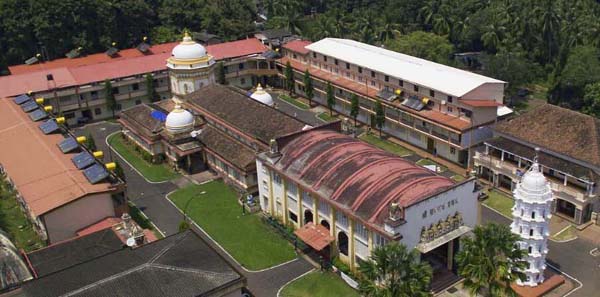Ramnathi Temple

Information of Ramnathi Temple, Ponda, Goa
The Ramnathi Temple is located in Bandora village in Ponda Taluka in the Indian territory of Goa. Bandora is around 30 kilometres from Panaji the capital of Goa. It is a Hindu temple dedicated to Lord Shiva by Lord Rama himself. This temple belongs to the Saraswat Brahmins. The Saraswat Brahmins belong to Kavale mutt & Kashi Mutt.
Ramnathi Temple Religious Significance
In this temple the Lord is referred to as Lord Ramanath. There is an idol of Lord Ramanath who is worshipped Lord Shiva but refers to as Lord Rama. In Hindu beliefs all Gods are one but just incarnations of different eras. There are other deities residing in the Panchayasthan which includes Shanteri, Kamakshi, Laxmi Narayan, Ganapati, Betal and Kalbhairav.
The temple is open from 7:30 in the morning till 9:30 at night throughout the year. The most important festival celebrated is the Maha Shiva Raatri for six days every year whenever the auspicious days fall. It usually falls during the month of February or March. It starts on Magh Vadhya Dwadashi and ends on Falgun Suddha Dwitiya. Another important festival celebrated yearly is the Navaratri Utsava Mahotsavam. This is the Dusshera festival celebrated for a period of ten days in a grand manner. It ends on Aswayuja Suddha Ekadasi and begins on Aswayuja Suddha Padyami.
Ramnathi Temple Mythology & History
The Ramnathi temple is about 450 years holding standing with its historical glory. According to Hindu legend the idol of the Ramnathi temple was installed by Lord Rama himself 3000 years ago in Rameshwar. After Lord Rama killed the Brahmin demon Ravana and returned from Lanka he prayed to Lord Shiva to forgive him for killing a Brahmin. He then installed a Shiva Linga and is called as Ramnath at present. So historically Lord Rama himself established the Ramnathi Temple.
The invasion of Portuguese in the 16th century in Goa was very common and they tried to demolish all Hindu structures. In order to prevent demolition the present temple was shifted 450 years ago from Loutoli in Salcette in Goa by Guad Saras Brahmins who were originally from Rameshwar in South India.
Ramnathi Temple Architectural Significance
The temple of Ramnathi is similar to all the Hindu temples located in Goa. It differs distinctively from rest of the temples in India. The architecture has been adopted from western as well as Muslim art because Goa was greatly influenced by foreign invasions as it is standing on the west coast of India.
The temple has a rigid structure and resembles local housing. The main shrine of the temple has a white dome in the place of a Shikhara which can be seen in most of the Hindu temples in India. There is another smaller but similar dome at the entrance of the temple. The presence of the dome indicates the influence from Muslim or Mughal architecture. The sanctum sanctorum consists of an idol of Lord Ramanathi who can be worshipped as Lord Rama as well as Lord Shiva. The idol resides on a beautiful throne and is decorated with ornaments and flower garlands.
This temple also has the Panchayasthan system that is it has four other smaller temples along with the main shrine.
The external wall of the temple is white washed with edges and boarders painted in yellow colour. It has lush green lawns giving the temple complex a natural and serene look.
- Andhra Pradesh Temples
- Assam Temples
- Bihar Temples
- New Delhi Temples
- Goa Temples
- Gujarat Temples
- Jammu and Kashmir Temples
- Karnataka Temples
- Kerala Temples
- Madhya Pradesh Temples
- Maharashtra Temples
- Odisha Temples
- Punjab Temples
- Rajasthan Temples
- Sikkim Temples
- Tamil Nadu Temples
- Telangana Temples
- Uttar Pradesh Temples
- Uttarakhand Temples
- West Bengal Temples